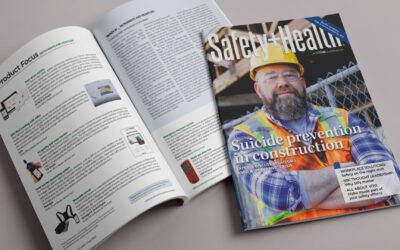
The FUSE Risk Management Platform is proven to considerably cut workplace manual material handling injuries by as much as half. That result provides real value to workers and enterprises, but there’s a third stakeholder who can dramatically benefit from StrongArm Tech’s FUSE Platform: Insurers. FUSE data has the ability to revolutionize how insurers assess risk and underwrite their accounts.
In an era where insurers are looking for new sources of leading indicator data to better assess and underwrite workers comp and construction risks, StrongArm fits that need.
FUSE collects physiological and environmental data from the bodies of workers. That data is then uploaded to a cloud-based system where it is analyzed and condensed into a “Safety Score” ¹ — a metric that indicates the musculoskeletal risk level for different workers in a specific job function, facility or company. The safer the worker’s movements, the higher the Safety Score.
Using FUSE’s data, workers comp and construction insurance underwriters can obtain real-time exposure information and gain better insight into client activities without incurring a claim.
Oliver Wyman, a leading global management consulting firm with deep insurance industry knowledge, has analyzed the FUSE’s impact on workers comp claims. This analysis shows that the FUSE can drive a measurable reduction in injury among worker and lower workers comp claims costs, and that StrongArm’s Safety Score is highly correlated to risk of injury.
With this validation, insurance underwriters should feel comfortable relying on the Safety Score to better understand which workers are most at risk for injury as well as how the insurer’s overall safety culture is impacting injury.
There are a few key ways underwriters can use FUSE data to more effectively underwrite risk.
- Underwriters could look at Safety Scores as part of the initial screening of a submission or to determine premium credits as part of the pricing exercise for a risk.
- If already on risk, underwriters could use FUSE to inform risk engineering. Safety Scores can be used as a barometer for effective changes – if the scores go up, the engineering solution was effective.
- If an account is adding new workers performing physical jobs to its payroll, the underwriter can use the Safety Score aggregated by job function to assess the new risk profile and adjust the price for the change in risk profile.
From a high-level perspective, a steady Safety Score would tell the underwriter that the insurer has a robust safety culture that is consistent and relatively predictable. That insight into safety culture along with claims incurred during the policy period can be insightful at renewal.
INSURERS OFTEN COLLECT DATA DURING THE CLAIM PROCESS THAT IS USEFUL FOR UNDERSTANDING SPECIFIC RISKS, BUT THIS COMES WITH A COST.
Any underwriter would agree that some of their most important information about an insured’s exposure is collected during the claim process. That’s great, but this information comes at the cost of incurring a claim in the first place!
The practice of relying on claims to collect information on an account is certainly not ideal from an underwriting profitability standpoint. FUSE can change that pattern by providing insights before a claim occurs. Using FUSE’s data, workers comp and construction insurance underwriters can obtain real-time exposure information and gain a better insight into client activities without incurring a claim.
THE BOTTOM LINE: INSURERS CAN IMPROVE UNDERWRITING PROFIT BY USING BETTER EXPOSURE DATA
Companies using wearables to improve worker safety may be more effective at underwriting risks for insurers, plain and simple. Implementing a safety wearable shows that the insurer is serious about reducing injuries and investing in injury reduction. Their safety teams are empowered with the ability to make data-driven decisions and understand where risk lives in their operation.
As more and more companies adopt and embrace safety wearables, isn’t it time you started to bring safety wearable data into the underwriting process?
¹ Safety Score is based on anergonomic risk model developed by Ohio State University’s Dr. William S. Marras




